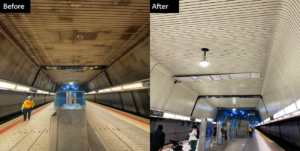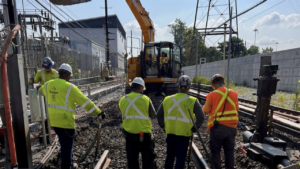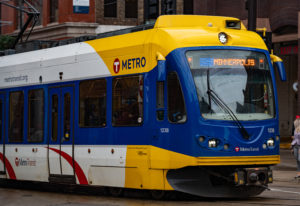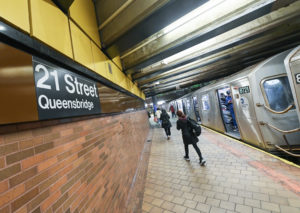Everything in its place
Written by Jenifer Nunez, assistant editor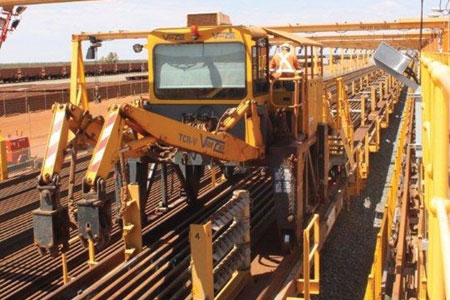
Suppliers manufacture and provide the most sophisticated tools for material handling to-date. With so many materials of various sizes and weights needed to build and maintain the railroads, multi-functional machines are in demand and suppliers across North America are delivering just that.
{besps}April13_materials{/besps}{besps_c}0|1materials0413.jpg|Vaia Car’s Rail Lobster.{/besps_c}{besps_c}0|2materials0413.jpg|GREX Dump Train provides flood remediation near Galena, Ill., in 2012.{/besps_c}{besps_c}0|3materials0413.jpg|Loram’s Rail Handling System.{/besps_c} {besps_c}0|4materials0413.jpg|Rcrane helping to perform bridge work.{/besps_c}{besps_c}0|5materials0413.jpg|R. J. Corman grapple truck working in its material yard.{/besps_c}{besps_c}0|6materials0413.jpg|V&H rotary dump truck.{/besps_c}
Suppliers manufacture and provide the most sophisticated tools for material handling to-date.
With so many materials of various sizes and weights needed to build and maintain the railroads, multi-functional machines are in demand and suppliers across North America are delivering just that.
Dymax
Dymax Inc. offers its 360-degree Grip N Ditch bucket, which is designed for 12-to 30-ton excavators. The 360-degree rotation to manipulate material from any position and the power clamp jaw features chromium carbide armor on the lead edge.
“It is ideal for cleanup work, avalanche removal, working inside tunnels or any type of maintenance or site improvement,” noted Allen Switzer, general sales manager. “For those with 30-ton excavators and pin grabber couplers, a tilt option is available in widths from 42-inch to 48-inch to 60-inch.”
Additionally, the Dymax Telescopic Rail Handler is available for 20-to 30-ton excavators. It is designed to grab and position 40-and 80-foot rails from piles and place them in position for flash-butt welding. Dymax notes that it is ideal for loading rails onto transport trailers/railcarts. Features include 30-degree rotation, high-tensile steel rail grabs using cylinders with lock valves, 24 V diverter valve and its manual telescopic arms extend up to 30 feet and has a storage stand, standard.
Georgetown
Georgetown Rail Equipment Company’s (GREX) DumpTrain has a 1,500-ton capacity and according to the company, provides pin-point delivery of aggregate.
Capable of unloading at speeds up to 2,000 tons-per-hour, the DumpTrain eliminates the need for additional equipment, manpower and time associated with material re-handling, noted GREX. It can handle several different sizes of aggregate, from walkway fines up to ballast of three-inch diameter. The boom of the DumpTrain has a rotation of 180-degrees and allows for material to be delivered anywhere from directly in front of the train to a distance of at least 35 feet from the center of track.
“As railroads continue to operate at maximum capacity, the need for efficient aggregate delivery has never been more important,” explained Lynn Turner, vice president of marketing and sales. “Work windows continue to shrink and our customers expect this trend to continue for years to come. Because of this, GREX is continually exploring ways to maximize efficiency, while observing the highest safety standards for our employees and customers.”
Because of the speed at which it unloads and the ability to pin-point delivery, GREX says railroads rely on the DumpTrain to get tracks back in service.
“Its capability to unload aggregate directly in front of itself allows the track to be repaired and put back into service much faster than by traditional means of material delivery,” explained Turner. “The sheer volume of aggregate that can be delivered allows our customers to operate day and night to get tracks back in service.”
Herzog
“There seems to be two commonalities among our railroad industry customers,” said Timothy Francis, vice president of marketing at Herzog Railroad Services, Inc. “The two subjects we discuss most often are safety and cost.”
The Herzog Automated Tie Down Car, in conjunction with its Rail Unloading Machine (R.U.M.) is the company’s answer to both of those concerns.
Every railroad allocates resources towards the labor-intensive task of unloading rail trains. In most cases, section gangs are taken away from their daily jobs in order to unload rail trains, Francis notes and says the Herzog R.U.M. eliminates that need.
Herzog provides two operators and, under the direction of a railroad provided foreman, the rail train can be unloaded. The R.U.M. can unload single or dual rails at up to 10 sticks per hour. The company says there isn’t a need to fish plate the rail when unloading or remove plates once the rail is on the ground.
“There is also no need to tie the first stick of rail off when first starting to unload the train,” Francis explained. “When utilizing the R.U.M. the need for the railroad to maintain and coordinate winch car movements from train to train is no longer a concern. The R.U.M. eliminates those needs and at the end of the day, it cuts away from the train and drives down the interstate to the next work location.”
The Herzog Automated Tie Down Car is operated by remote control. With the turn of a knob and flip of a switch, the pocket to unload is unclamped. The rail is then pulled and the process starts all over again. Herzog Railroad Services, Inc., says the need for a tie down crew has been eliminated and the slip, trip and fall concern is removed and the time spent unclamping is cut down from a three and a half minute average to six seconds.
“The Automated Tie Down Car and R.U.M. reduce exposure and, therefore, reduce the opportunity for injury,” noted Francis. “Of course, along with safety, there are quantifiable productivity improvements that can lead to reduction of rail train cycle times, reduction of curfews and increased time to run revenue freight.”
Loram
“The current North American rail train fleet is utilizing antiquated technologies that do not provide the productivity or safety that railroads are starting to demand,” noted Bradley Willems, director of marketing and business development at Loram Maintenance of Way, Inc. “As railroads look to renew rail train fleets in the coming years, there will be an opportunity for firms to increase the productivity and safety of rail train operations. Productivity and process improvements will lower the overall cost of rail logistics through increased handling capacity and the ability to pick up and transport rail in a state that allows it to easily be relayed or scrapped.”
With safety and productivity being key factors, Loram offers customers its Rail Handling System, which it notes has double the loading productivity of traditional rail trains at 3,000 feet-per-hour and provides a product that is relay rail ready. Loram’s Rail Handling System was designed to diminish the risk of injury by reducing the human interaction with the rail.
“One of the key advantages of Loram’s equipment is that it retains total control of the rail while loading and unloading,” Willems said. “The equipment also provides a very stable and ergonomic work station that locks the rail in place mechanically when there is a need for an operator to come in to physical contact with the rail.”
Mitchell Equipment
Mitchell Equipment has developed a friction drive hi-rail package for a 55-ton rough terrain crane. The company says the Terex RT 555-1 is the largest friction drive hi-rail crane ever made and is far more economical than using a permanent rail-bound crane. Additionally, it has the ability to get off track and can be used on both the rail and on the ground.
Mitchell has developed an alarm system to be used with friction drive hi-rail, whereby, if for any reason, any of the four friction drive hubs should loose contact with the tire, an alarm sounds, alerting the operator to stop the crane.
“This feature prevents possible free-wheeling of the crane on rail,” explained Estel Lovitt, Jr., president. “This is a huge safety feature that Mitchell installs on all friction drive hi-rail systems it produces and in our opinion, it should be a mandatory system for all friction drive hi-rail systems for all manufactured machines that operate on the railroads.”
RCE
Rail Construction Equipment Company (RCE) has expanded its line of material handling carts by introducing the Rail Dump Cart. The cart has the capability of delivering OTM, ballast and can be used for removal of material during ditching. This product can be used with RCE hi-rail excavators and hi-rail swing loaders.
“I believe that budgets are still tighter than past years, but 2013 looks promising from the amount of current interest for product quotations,” noted Dennis Hanke, sales manager. “I feel that the railroads are looking for innovative ideas and processes to get their track maintenance projects completed.”
Rcrane
Bridge and track budgets are always tight in both time and cost. Rcrane is designed to build bridges fast and replace track with longer/heavier bridge and track panels.
“The Rcrane system keeps the work on track, maximizing safety and productivity for bridge and track construction,” said Paul Markelz, president and founder of Rcrane, LLC. “Performing all lift operations with dual hoists straddling the work area guarantees safety of the workforce and reliable, on-time completion of the work.”
The system completes delivery, removal, disposal and installation all in one trip and the company notes that it has achieved new levels of construction speed. Rcrane has added several features, such as on-board fall arrest systems and new levels of performance and ease of use, as well as adding new failsafe features to the rugged hoist support systems. Additionally, a second set of Rmule material transfer dollies to simultaneously transfer both old removed materials and new delivered materials on Rflat material delivery flat cars have been added.
“When all aspects of downtime and reliability of work completion are considered,” noted Markelz. “Rcrane delivers new levels of time and cost value that helps our customers run more trains on time at full speed. Features that decrease cost and time to complete mission-critical operations so track can reopen for rail traffic are important to our customers and makes it much easier to keep rail shipping customers satisfied.”
R. J. Corman
R. J. Corman Railroad Company/Material Sales provides full-service material management and distribution out of its 10 maintenance-of-way material yards. The yards span from Albany, N.Y., to Starke, Fla., and provide 24/7 service.
“Switch points and stock rails don’t wait until 8:00 a.m. to fail,” said a company representative. “We’re there when that happens. Our grapple trucks’ maneuverability increases opportunities for delivering maintenance-of-way material to exact locations, whether it is switch components, frogs, ties, etc. This enables our customers’ achievement of two main objectives: improved labor and cost efficiencies.”
R. J. Corman notes safety is its top priority. The company is constantly searching for safer, more advanced equipment, such as its remote-controlled grapple trucks.
A material sales spokesperson said, “We are determined to bring innovative improvements to maintain our high operating standards, the standards which have earned our reputation as the company our customers trust to get the job done.”
V&H
V&H Inc., Trucks, uses AR450 (abrasion resistant) steel on its material handler and rotary dump truck bodies. This abrasion-resistant steel is intended to haul abrasive and high-impact materials, such as rip-rap, crossties, spikes and other material that can destroy a bed after a few years of service.
“We have tested the AR450 steel for about five years and you cannot see dents, tears and wavy surfaces that you would see with mild steel,” said Tim Minor, railroad specialist, Kansas Division.
The proportional hydraulic control on V&H’s rotary dump truck allows the operator the ability to feather the bed in any direction through a joystick control in the cab or with the hydraulic valve outside of the truck. The company says customers like the positive control that it gives them when dumping a load or even a simple task, such as stowing the bed, while never having to take their eyes off of the load.
“The market for material handlers and rotary dump trucks is softer than it was a year ago at this time,” Minor noted. “We think this is due to the fact that we actually had a winter this year. Last year’s winter was extremely mild, which allowed the year’s work window to move up significantly and of course the rental, leasing and sales market followed suit.”
Vaia Car
Vaia Car’s TCR-V Rail Crane (Lobster) is designed for safe and efficient delivery of rail to the jobsite and the pickup of rail removed from the track. The Lobster, working in conjunction with special rail cars, can handle continuous welded rail and was made for tight work windows and restrained budgets.
Operating from track-mounted special cars, the Lobster is capable of handling rail up to 1,640 feet in length. The rails are handled two at a time by one Lobster operator, plus a small support crew.
“Powered by a 177 hp diesel engine coupled to double hydraulic pumps, provide power to all four wheels for traction with variable speeds in either direction,” noted Cal Coy, Bridgewater Inc. consultant for Vaia Car. “The unit is equipped with hydraulically-operated brakes, acting on all four wheels and the driving cab is rear-access with wide visibility. It is sound dampened, air conditioned and heated for operator comfort. All controls and instrumentation are purposely located for ease of operation.”

